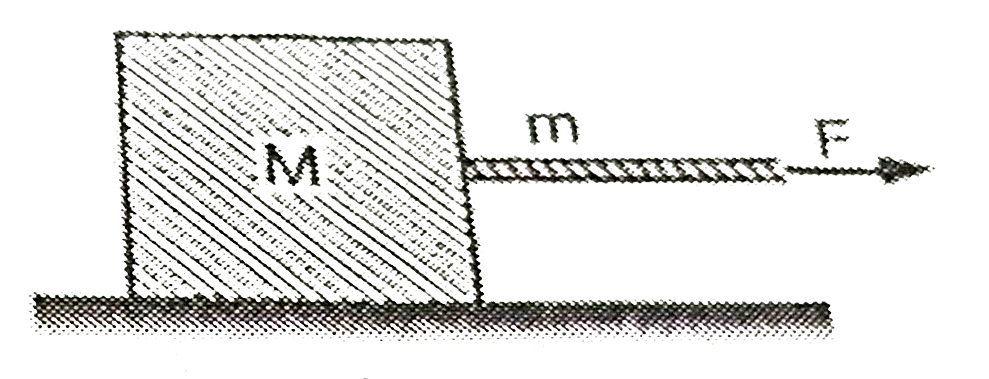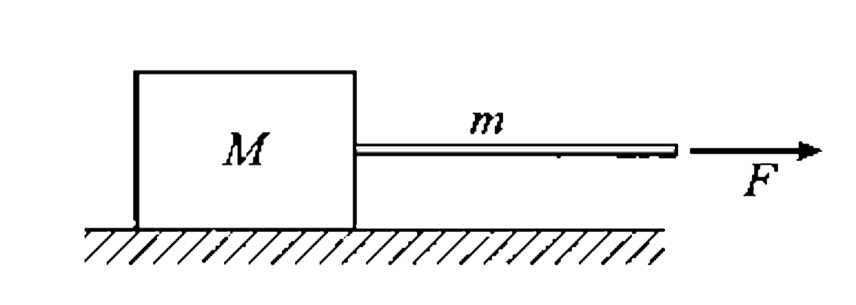A block of mass M is pulled along a horizontal frictionless surface by a rope of mass m. If a force P is applied at the free end of the rope, the force exerted by the rope on the block is
(a) PmM+m
(b) PmM−m
(c) P
(d) PMM+m
The correct Answer is:D
To solve the problem of finding the force exerted by the rope on the block when a force P is applied at the free end of the rope, we can follow these steps:
Step 1: Understand the System
We have a block of mass M on a frictionless surface, and it is being pulled by a rope of mass m. A force P is applied at the free end of the rope.
Step 2: Identify the Total Mass Being Accelerated
When the force P is applied, both the rope and the block will accelerate. The total mass that is being accelerated is the sum of the mass of the block and the mass of the rope:
Total Mass=M+m
Step 3: Apply Newton's Second Law
According to Newton's second law, the net force acting on the system is equal to the total mass times the acceleration (A):
P=(M+m)⋅A
From this, we can express the acceleration A:
A=PM+m
Step 4: Calculate the Tension in the Rope
The tension T in the rope can be found by considering the block of mass M alone. The only force acting on the block is the tension T, which causes it to accelerate:
T=M⋅A
Substituting the expression for A from Step 3:
T=M⋅(PM+m)
Thus, the tension T (which is the force exerted by the rope on the block) is:
T=M⋅PM+m
Final Answer
The force exerted by the rope on the block is:
M⋅PM+m
We have a block of mass M on a frictionless surface, and it is being pulled by a rope of mass m. A force P is applied at the free end of the rope.
When the force P is applied, both the rope and the block will accelerate. The total mass that is being accelerated is the sum of the mass of the block and the mass of the rope:
Total Mass=M+m
According to Newton's second law, the net force acting on the system is equal to the total mass times the acceleration (A):
P=(M+m)⋅A
From this, we can express the acceleration A:
A=PM+m
The tension T in the rope can be found by considering the block of mass M alone. The only force acting on the block is the tension T, which causes it to accelerate:
T=M⋅A
Substituting the expression for A from Step 3:
T=M⋅(PM+m)
Thus, the tension T (which is the force exerted by the rope on the block) is:
T=M⋅PM+m
The force exerted by the rope on the block is:
M⋅PM+m
Topper's Solved these Questions
- HEAT AND THERMODYNAMICSBOOK - SUNIL BATRA (41 YEARS IITJEE PHYSICS)CHAPTER - HEAT AND THERMODYNAMICSEXERCISE - JEE Main And Advanced
219 Videos
- MECHANICAL PROPERTIES OF MATTER AND FLUIDSBOOK - SUNIL BATRA (41 YEARS IITJEE PHYSICS)CHAPTER - MECHANICAL PROPERTIES OF MATTER AND FLUIDSEXERCISE - Subjective Problems
1 Videos
Similar Questions
A block of mass M is pulled along a horizontal frictionless surface by a rope of mass m. If a force P is applied at the free end of the rope, the force exerted by the rope on the block will be
View SolutionA block of mass M is pulled along a horizontal frictionless surface by a rope of mass m. If a force F is applied at one end of the rope. Find the force which the rope exerts on the block.
View Solution
Knowledge Check
A block of mass M is pulled along a horizontal frictionless surface by a rope of mass m. If a force F is applied at one end of the rope, the force which the rope exerts on the block is :
AF/(M+m)BFCFM(m+M)D0A block of mass M is pulled along a horizontal frictionless surface by a rope of mass m . Force P is applied at one end of rope. The force which the rope exerts on the block is:
AP(M−m)BPM(m+M)CPM(m+M)DPM(M−m)A block of mass 2 m is pulled along a horizontal frictionless surface by a rope of mass m as shown in the figure given. What force is exerted by the rope on the block ?
 AF3BF2C2F3DF
AF3BF2C2F3DF
A block of mass M is pulled along a horizontal frictionless surface by a rope of mass m . A force P is applied to the other end of the rope . (a) Find the acceleration of the block and the rope . (b) Find the force that the rope exerts on the block M in terms of P, M and m .
View Solution
A block of mass 2 m is pulled along a horizontal frictionless surface by a rope of mass m as shown in the figure given above. What force is exerted by the rope on the block ?
View SolutionA block of mass M is pulled along a horizontal frictionless surface by a rope of mass m as shown in A horizontal force F is applied to one end of the rope. Find
(a) the acceleration of the rope and block
(b) the force that the rope exerts on the block
(c) the tension in the rope at its mid point

View SolutionA block of mass M is pulled along a horizontal frictionless surface by a rope of mass m, as shown in figure-2.27. A horizontal force F is applied to one end of the rope. (a) Find the force the rope exerts on the blocks, and (b) the tension in the rope at its midpoint.

[MFM+m,(m+m/2)FM+m]
View SolutionA block of mass M is pulled along a horizontal frictionless surface by a rope of mass m, as shown in Fig. 5-35. A horizontal force acts on one end of the rope.

(a) Show that the rope must sag, even if only by an imperceptible amount.
(b) Then, assuming that the sag is negligible, find the acceleration of rope and block.
(c) Find the force on the block from the rope.
(d) Find the tension in the rope at its midpoint.
View Solution
